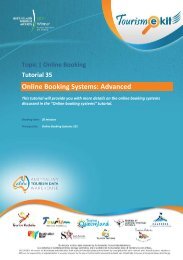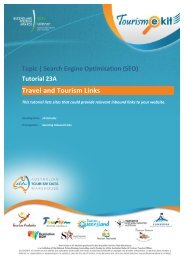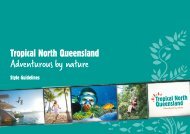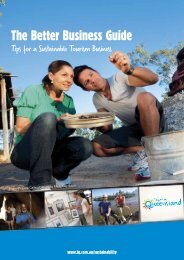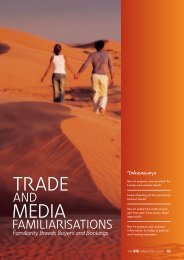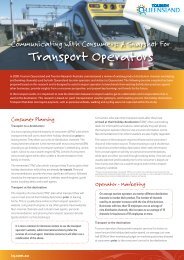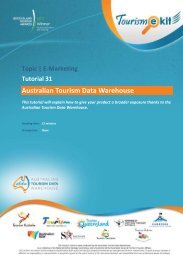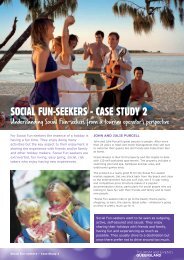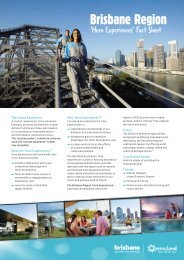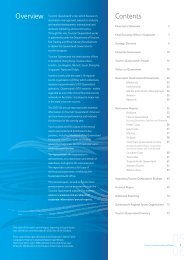Tourism Opportunity Plan - Tourism Queensland
Tourism Opportunity Plan - Tourism Queensland
Tourism Opportunity Plan - Tourism Queensland
You also want an ePaper? Increase the reach of your titles
YUMPU automatically turns print PDFs into web optimized ePapers that Google loves.
1 Context<br />
Gold Coast Dining, Marina Mirage<br />
1.1 Purpose – What is a <strong>Tourism</strong><br />
<strong>Opportunity</strong> <strong>Plan</strong>?<br />
The Purpose of the Gold Coast and Hinterland <strong>Tourism</strong> <strong>Opportunity</strong><br />
<strong>Plan</strong> (TOP) is to provide direction for the sustainable development of<br />
tourism in the Gold Coast region.<br />
This document is an update of the Gold Coast and Hinterland<br />
<strong>Tourism</strong> <strong>Opportunity</strong> <strong>Plan</strong> 2009 – 2018 reflecting that since the<br />
inception of this document in 2008, the tourism environment on the<br />
Gold Coast has changed.<br />
The projects and opportunities identified in the 2008 TOP were<br />
determined in a very different tourism environment. The purpose<br />
of updating the Gold Coast TOP is to refocus the direction for the<br />
sustainable development of tourism in the region to 2020.<br />
Since the original Gold Coast TOP was developed in 2008, a<br />
number of key deliverables for the project have also been met, while<br />
others need to be reviewed and prioritised. It is anticipated that<br />
this updated document will provide a renewed and reinvigorated<br />
direction for the sustainable development of tourism in the Gold<br />
Coast region.<br />
The Gold Coast and Hinterland TOP update will:<br />
Re-prioritise the identification of new and upgraded tourism<br />
product that meets visitor expectations and demands;<br />
Re-prioritise the need for new investment in infrastructure that<br />
supports the ongoing development of tourism;<br />
Re-prioritise relevant research based information on tourism<br />
supply and demand;<br />
Provide a renewed focus and reinvigorate engagement with the<br />
tourism industry, infrastructure providers and private investors;<br />
and support the vision of the Gold Coast as outlined in the Gold<br />
Coast Destination <strong>Tourism</strong> Strategy.<br />
1.2 Current <strong>Tourism</strong> Environment<br />
The <strong>Queensland</strong> Government held the inaugural DestinationQ<br />
forum in Cairns on 25 and 26 June 2012. The forum provided an<br />
opportunity for more than 300 tourism industry representatives to<br />
contribute to the policy direction of the <strong>Queensland</strong> Government.<br />
The forum culminated in the development of a Partnership<br />
Agreement between industry and government. A key element of the<br />
Partnership Agreement included the recognition that both industry<br />
and government must work together cooperatively, and contribute<br />
jointly, to achieving the <strong>Tourism</strong> 2020 goals. This principle will<br />
also apply to the projects outlined in this TOP. This will require that<br />
industry, and federal, state and local governments all play a role in<br />
delivering these projects.<br />
The Gold Coast TOP is an adjunct to the Gold Coast Destination<br />
<strong>Tourism</strong> Strategy, which was released in 2012 and provides the<br />
framework to guide tourism industry development in the Gold Coast<br />
by coordinating stakeholders in a common direction to maximise<br />
the tourism potential of the destination. The TOP’s role as part of<br />
this framework is to act as a guide to government, industry and<br />
stakeholders as to projects and action steps the industry believes<br />
are required, for the most effective impacts on tourism.<br />
In addition to stakeholder feedback since the release of the original<br />
TOP in 2008, the updated TOP is based on extensive research<br />
as well as consultation with a range of regional and external<br />
stakeholders including government agencies, tourism industry,<br />
external tourism stakeholders, developers and investors.<br />
The updated Gold Coast TOP does not assert to canvass all possible<br />
projects for the region but instead makes recommendations based<br />
on the catalyst projects identified in the original plan and which fulfil<br />
the destination objectives, have strong stakeholder support and<br />
are likely to assist in realising the destination’s long term vision for<br />
sustainable tourism.<br />
The TOP does not imply endorsement by local, state or federal<br />
governments, nor does it imply funding commitments. The TOP<br />
is a list of the key catalyst projects developed by industry with the<br />
assistance of government, to guide the planning and development<br />
of projects that offer the tourism industry the best available<br />
opportunities for growth.<br />
For the purposes of this project, the Gold Coast region is defined by<br />
the Gold Coast City Council boundaries which includes 47 Statistical<br />
Local Areas (SLAs) extending from Beenleigh in the North,<br />
Coolangatta in the South and Lower Beechmont and Springbrook in<br />
the West. The Gold Coast contains a number of nodes or precincts<br />
of tourism activity or high levels of visitation.<br />
1 Context<br />
1




